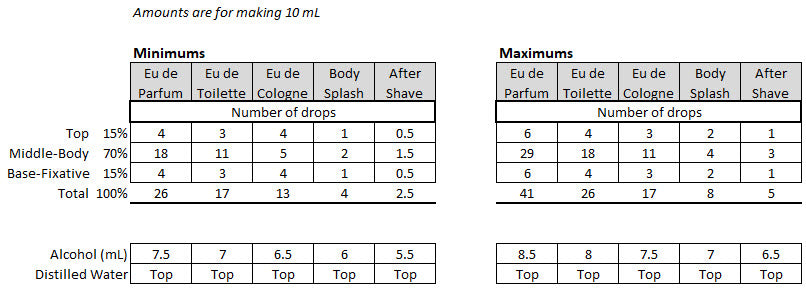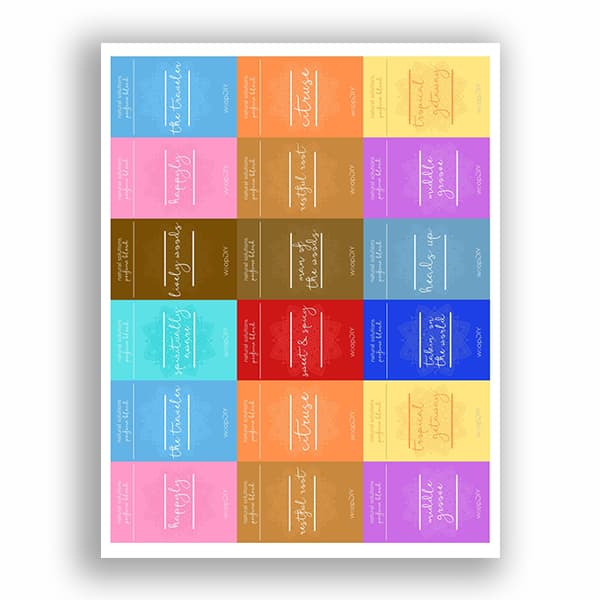The Ultimate Guide to Making Essential Oil Perfume Blends
You know those stinky, overpowering department store perfumes?
You know how they drive you bonkers and you can’t get the smell out of your nose?
Well in this perfume blending guide we’re going to show you how to make perfume with essential oils (that actually smells good) and wear them as fragrance!
We are going to help you with creating your (new) favorite scents with essential oils, with a limited amount of ingredients (that you most likely have on hand).
P.S. These can make awesome gifts too!
In this guide we’ll help you understand the different notes involved in a perfume to help you create your own essential oil blend as well as giving you a few ideas of some blends we love.

Table Of Contents
Essential Oil Notes
There are three essential oil perfume notes you’ll need to become familiar with when you make your customized blend: the top note, the body note and the base note.
Top notes
Makes between 10-20% of the blend.
These essential oils have the characteristic of being very volatile (they evaporate very quickly). This means that you will get the full scent very quickly and then the scent will dissipate very quickly.
Because of this characteristic, this scent will give the first impression of the perfume blend. The scents of the oils in this note will tend to be light, fresh, and uplifting.
Common oils in the top note will be: Basil, Bergamot, Clary Sage, Coriander, Eucalyptus, Grapefruit, Lemon, Lemongrass, Lime, Wild Orange, Peppermint, Petitgrain, Spearmint, Tangerine, Melaleuca and Wintergreen.
Body Notes or Middle Notes
Makes between 60-80% of the blend.
These essential oils will give the full body to the perfume blend. These are not quite as volatile as the Top Notes and will take a little longer to be noticed (typically 20-60 minutes after application).
Generally these will be warm and comforting scents.
Common oils in the middle note will be: Black Pepper, Cardamom, Cilantro, Cypress, Douglas Fir, Sweet Fennel, Geranium, Juniper Berry, Lavender, Marjoram, Melissa, Oregano, Roman Chamomile, Rosemary, Spikenard, Thyme and Siberian Fir.
Base Notes or Fixative Notes
Makes up between 10-20% of the blend.
These essential oils will have a more foundational fragrance. They will be noticable for quite awhile (typically an hour or two after application) and they also slow down the evaporation of the oils from the top two notes.
These will generally have the fragrance of being very rich and also very relaxing in nature.
Common oils in the base note essential oils list will be: Arborvitae, Blue Tansy, Cassia, Cedarwood, Cinnamon Bark, Clove Bud, Copaiba, Frankincense, Ginger, Helichrysum, Jasmine, Myrrh, Patchouli, Rose, Sandalwood, Vetiver, Ylang Ylang

Perfume ingredients & supplies
What ingredients and supplies will you need to create your perfume? Here is a list of what you will need:
- Certified Pure Therapeutic Grade essential oils
- Alcohol
- Distilled Water
- Fractionated coconut oil (or other carrier oil like jojoba oil)
- Beeswax (for the solid perfume)
- Container(s) to hold the perfume
Creating Your Blend
The first thing you should keep in mind is that everything in this guide (and any other guide you’ll read) is just a suggestion or recommendation. Making your own scents is more of an art than it is a science.
What might be a perfect blend for one person, could be one of the worst smelling blends to the next person. Experiment and play around with them to find what works best for your particular body chemistry.

blending tip
TIP: Take the different oils you have selected for your blend, take off the caps and hold all of the bottles together and wave under your nose. This will give you a little preview of the blended scent.
We suggest having a notebook for your blends you try so that you can make notes as you go through the blending, then refer back to them the next time and try something a little different until you come up with your perfect signature scent.
- If you blend according to note you should select no more than three to seven oils from the three note families.
- Several recommendations are 1:1:1, 3:2:1, 4:2:1 [top:body:base]
- For instance, if you did the 3:2:1, you would select 3 oils for the top note, 2 oils for the body note and 1 oil for the base note.
- Put a drop of your base note into a bottle and smell. Write down your thoughts.
- Add a drop of the middle note, swirl around and smell. Is there a change? Write it down.
- Add a drop of top note, swirl around and smell. Is there a change?
- Add several top and middle drops at a time now. How does it change?

clearing your smell palate
If you need to clear your olfactory palate, inhale some coffee beans. Similar to swishing with water when tasting different wines it’ll reset your sense of smell.
- Let this sit for a day or two and see how the smell changes.
- You can put onto a cotton ball and smell to see how it changes when exposed to air. This will smell a little differently than straight out of the bottle.
- Best case, add to your skin and smell. Your blends will smell differently once blended with different skin types.
- Play around with this and have fun! See if you can “recreate” a blend that is similar to a perfume or scent from your past that elicits happy emotions.
Determining the type of your perfume
Next you will need to determine what type of perfume you are looking to make. There are 5 different types that you can choose from. The difference between each one will be how much essential oils or fragrance, is contained in each one - how strong the scent is.
It will go from Eu de Parfum as the strongest to After Shave that is the weakest.
- Eau de Parfum will have between 26 - 41 drops of oil in it.
- Eu de Toilette will have between 17 - 26 drops of oil in it.
- Eu de Cologne will have between 13 - 17 drops of oil in it.
- Body Splash will have between 4 - 8 drops of oil in it.
- After Shave will have between 2.5 - 5 drops of oil in it.

Using the essential oil note chart above, if you wanted to create an Eu de Toilette blend you would use the following:
- 3 – 4 drops of the Top note
- 11 – 18 drops of the Middle/Body note
- 3 – 4 drops of the Base/Fixative note
- 7 – 8 mL of alcohol
- Fill the rest with distilled water
To make things even easier, you can use our essential oil perfume ingredient calculator
Application methods for your DIY perfumes
There are three ways you can apply your homemade DIY essential oil perfume: Spray, Roller Bottle or Solid. We want to keep safety in mind, so we want to mention that you should use caution when applying any blend containing citrus oil to a part of the body that is exposed to sunlight, as citrus oils are photosensitive. It is recommended to apply those blends to areas that will be covered with clothing.
Spray perfume
This is the most common way people choose to apply their essential oil perfume. You can get small and compact essential oil spray bottles that are easy to carry around and allow you to make smaller batches and play around with different blends. The options for spray bottles are as unique as the blend you make, so find one that suits the blend and most importantly, suits YOU.
Roll on perfume
Using a roller ball bottle to put your blend in is another very popular option. Generally the roller bottles are used for blends other than a perfume, but don’t get us wrong, it’s a fantastic way to carry around your perfect scent to apply to your pulse points when the time suits you. Small and compact like the spray, the possibilities are endless.
Solid perfume
A little less common method is to create a solid perfume with your pure essential oils. The reason this is a little less common is that there are a few more steps and ingredients involved. The benefit of this solid perfume is that there’s no chance of it leaking. It is crazy portable in a small container and simply a nice alternative to the sprays or roll ons that you may have become accustomed to. Additionally, solid perfumes often offer a stronger scent.
12 Easy Perfume Blends for You [AND him]
Here are some blends that can help get you started. Play around with these and HAVE FUN!
6 Blends For Her (Perfume)
The Traveler
- 3 drops Wild / Sweet Orange
- 5 drops Lime
- 3 drops Juniper Berry
- 3 drops Cinnamon Bark
- 4 drops Frankincense
Citruse
- 5 drops Lemon
- 3 drops Rosemary
- 4 drops Wild / Sweet Orange
Tropical Getaway
- 5 drops Lavender
- 4 drops Wild / Sweet Orange
- 1 drop Ylang Ylang
Happyly
- 4 drops Bergamot
- 4 drops Geranium
- 2 drops Vetiver
Restful Root
- 6 drops Lavender
- 2 drops Vetiver
- 2 drops Lemon
Middle Groove
- 4 drops Lavender
- 4 drops Green Mandarin
- 2 drops Juniper Berry
6 Blends For Him (Cologne)
Lively Woods
- 8 drops Fir
- 8 drops Wild / Sweet Orange
- 4 drops Frankincense
Man of the Woods
- 8 drops Basil
- 8 drops Black Spruce
- 4 drops Helichrysum
Heads Up
- 10 drops Cardamom
- 3 drops Vetiver
- 3 drops Ylang Ylan
Spirtuallly Aware
- 10 drops Cypress
- 10 drops Bergamot
Sweet and Spicy
- 10 drops Black Pepper
- 7 drops Coriander
- 3 drops Hawaiian Sandalwood
Takin’ On The World
- 10 drops Cypress
- 9 drops Marjoram
- 1 drop Wintergreen
Essential Oil Perfume Labels
Once you make your scents, it is always great to be able to label them so you know what is in the bottle. Below you will find some easy 2x2 labels that you can print out and apply them yourself.
The best way for a DIY label that we have found, is to cut some clear packing tape a little bigger than your label and use that to apply it. Not only will it keep the label on the bottle, it will also provide a mild form of protection for the label so it stays nicer a little while longer

Essential Oil Perfume Recipe FAQs
What is the best essential oil for perfume?
Common essential oils used solely on their own for perfumes are: Lavender, Patchouli, Jasmine, Rose, Lemongrass, Sandalwood, Wild Orange.
How do you make perfume with essential oils?
Perfume with essential oils is made of a mixture of 3 notes: Top, Middle and Base, a solubilizer and distilled water.
What ingredient makes perfume last longer?
The base, or fixative, notes are what will give your essential oil perfume the longevity and staying power. More of the base note in the blend will have your scent lasting hours.
Can you wear essential oils as perfume?
The answer is a resounding yes. While today’s store bought perfumes consist of synthetic fragrances, the origins of perfume come naturally from plants and flowers.


